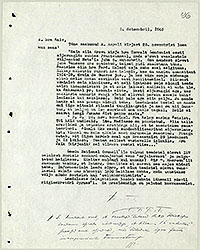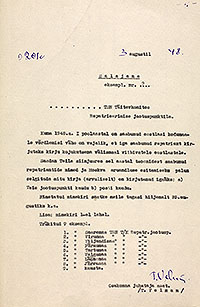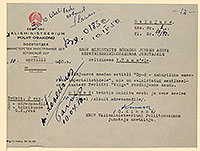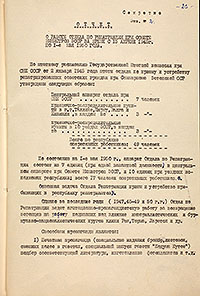Repatriation
Shortly after the end of the Second World War, displaced persons were seen as a problem to be solved only by repatriation, namely sending them back to their homelands. It was hoped that by the end of the war the majority of DPs would return home and repatriation could be carried out without using force. Repatriation directly affected the definition of citizenship based on decisions at the Yalta Conference, it was found that citizens of the Baltic States were now citizens of the Soviet Union who needed to be sent back, and if they would not go voluntarily, then they should be forced to go.
The first forced repatriations were carried out in the spring of 1945, which culminated in the use of physical force, suicide attempts and suicides, as shown by Ukrainian and Belorussian statistics from the Kempten camp. There was also forced repatriation among Estonians, in particular in the US zones in Germany and Austria. In November 1945, military governments of three zones did not recognise the occupation of the Baltic States by the Soviet Union, and therefor Baltic citizens were not considered citizens of the USSR. The UNRRA, not the military authorities, conducted forced repatriation of Baltic DPs. This occurred despite the fact that according the two powers agreement, the UNRRA should have assisted the military repatriation, but could not send anyone home, even forcibly. However, the activities of the UNRRA were based in particular on political interests, and the UNRRA allowed unhindered visits from Soviet Union repatriation teams to Baltic DP camps, creating propaganda for repatriation as well as forced repatriation. In summary, the fate of Estonians, like with other Balts was dependant on the concrete political views of camp officials and the knowledge of Baltic history.
The number of Estonians that returned from Germany to Estonia was estimated between 700800 by international DP organisations: during the UNRRA administration 479 people or 1.5% of the total number were repatriated, in the subsequent period, primarily during IRO activities, 256 Estonians were repatriated. However, according to Soviet statistics, slightly more than 7200 Estonians were repatriated from Germany.
Since many of those repatriated from the camps were Balts, including the Estonians, the authorities began to look for other solutions to DPs situation. Those that did not return to their homeland had to choose between resettlement, and integrating into the local community (i.e. staying in Germany).| A letter by Karl Robert Pusta to Estonian consul general, Mr. Johannes Kaiv, in the matter of repatriation of prisoners in the zone of France. December 5, 1945. ERA.1622.2.36, page 96 (digitized, www.ra.ee/saaga) |
|
| A circular letter of repatriation department of Estonian SSR Council of Ministers to the relevant distribution locations there is referred that every repatriate must write letters to the Estonians abroad for to activate the repatriation. Also, there are included lists of repatriates county by county in the letter. ERA.R-1789.1.62, page 4 |
|
| A covering letter of political department of Estonian SSR to the article of "DPs cannon fodder for American imperialists". The article was planned to publish in an Estonian broadcast of radio station "Volga" in Berlin. April 10, 1950. ERA.R-1789.1.99, page 12 |
|
| A report of repatriation department of Estonian SSR about the period of April 15, 1945 May 1, 1950. In addition, there are a list of propaganda materials as well as statistical information of repatriates country by country in the relevant report. ERA.R-1789.1.100, pages 2332 |





